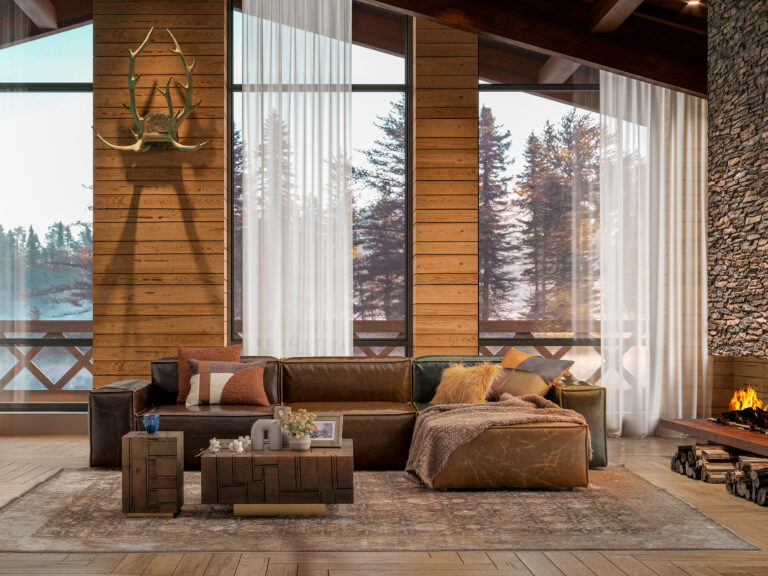How to Design Your Home in Industrial Style: Complete Guide
Welcome to LEOPARD Furniture, your premier destination for high-end furniture and exceptional interior design services in Montreal, QC. In this guide, we’ll delve into the rugged charm and raw elegance of industrial style, offering a step-by-step approach to transforming your space into an urban sanctuary.
Understanding Industrial Style
Industrial style emerged during the late 19th and early 20th centuries, originating from the conversion of former industrial spaces into residential lofts. Inspired by the utilitarian beauty of factories and warehouses, industrial design celebrates raw, urban aesthetics, exposed materials, and functional decor. It embraces the history and character of these spaces, preserving their rugged charm while reimagining them for modern living.
Color Palette
The color palette in industrial style is a mix of neutral tones and muted hues, including shades of gray, brown, black, and white. These colors serve as a backdrop for the raw materials and textures commonly found in industrial spaces, such as exposed brick, wood, concrete, and metal. Wood is used in this style if you want to create a warmer space, while concrete and metal can be utilized for a cooler, more minimalist look. Accents of rich, earthy tones like rust or olive green can add depth and warmth to the space.
In the living room image provided, notice how the natural stone fireplace, aged look area rug, and wooden walls complement the industrial color palette, adding warmth and texture to the space. The cubic leather modular sofa, with its clean lines and raw finish, embodies the rugged elegance of industrial design, while the high-quality cubic wood brick coffee table adds a touch of warmth and authenticity.
Materials
Industrial style celebrates the beauty of raw, unfinished materials, including exposed brick, wood, concrete, and metal. These materials are often left in their natural state, showcasing their inherent textures and imperfections. Leather, distressed fabrics, and utilitarian metals like steel or iron are also common in industrial design, adding to the rugged charm of the space. Aged rugs are common in this style, adding warmth and character to the floors.
Furniture and Decor
Furniture in industrial style is characterized by its sturdy construction, simple forms, and utilitarian appeal. Look for pieces with clean lines and raw finishes, such as metal-framed sofas or without frame sofas, wooden coffee tables, and industrial-style lighting fixtures. Leather dining chairs are preferred in this style, adding a touch of sophistication and warmth to the dining area. Incorporate functional decor elements like exposed pipes, salvaged machinery parts, and vintage signage to add authenticity to the space.
Designing Each Room
Living Room
The living room serves as the focal point of industrial style, with its emphasis on communal gathering and relaxed comfort. Create a cozy seating area with a cubic leather modular sofa like the Poufy, paired with fabric and leather cushions for added texture. Incorporate natural elements like a stone fireplace and aged look area rug to enhance the industrial aesthetic.
Dining Room
In the dining room, opt for a sturdy wooden table paired with leather dining chairs featuring metal or wooden frames. Choose leather in rich, earthy tones like brown or black to complement the industrial aesthetic. Keep the space open and airy, with plenty of natural light and exposed materials. Add industrial-style lighting fixtures and vintage accents to create a unique and inviting dining experience.
Bedroom
The bedroom should exude an urban sanctuary vibe, with a mix of raw materials and cozy textures. Choose a sturdy wooden bed frame and pair it with industrial-style bedside tables and lighting fixtures. Layer soft bedding and throw blankets in neutral tones to add warmth and comfort to the space.
What to Avoid
When designing in industrial style, avoid overly polished or ornate furnishings that detract from the rugged charm of the space. Steer clear of bright or garish colors, opting instead for muted tones and earthy hues that complement the raw materials and textures of industrial design. Additionally, avoid clutter and excess decor, as industrial style values simplicity and functionality above all else. Be cautious not to overwhelm the space with too many industrial elements, as balance is key to achieving a cohesive and inviting atmosphere.

